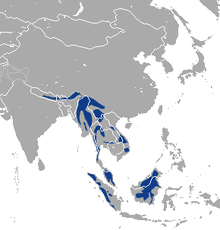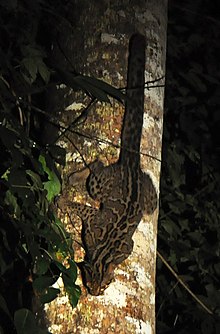Marbled cat: Difference between revisions
Extended confirmed users, Pending changes reviewers 53,965 edits →Taxobox: corr year of 1. description |
Extended confirmed users, Pending changes reviewers 53,965 edits →Conservation: extended with ref |
||
| Line 51: | Line 51: | ||
==Conservation== |
==Conservation== |
||
''Pardofelis marmorata'' is included in [[CITES Appendix I]] and protected over parts of its range. Hunting is prohibited in [[Bangladesh]], [[Cambodia]], [[Yunnan]], India, Indonesia, Malaysia, Myanmar, Nepal and Thailand. Hunting is regulated in [[Lao PDR]] and [[Singapore]]. In Bhutan and [[Brunei]] the felid is not legally protected outside protected areas. No information about protection status is available from [[Vietnam]].<ref name="nowell96">{{cite book |author= Nowell, K., Jackson, P. |year= 1996 |title= 'Wild Cats: status survey and conservation action plan |publisher=IUCN/SSC Cat Specialist Group, Gland, Switzerland |url=http://www.catsg.org/catsgportal/cat-website/catfolk/marmor01.htm}}</ref> |
|||
It is rarely sighted in its densely forested habitat, and little studied or understood. Its population is estimated at below 10,000 mature individuals. Its forested habitats have been shrinking, accounting for its vulnerable listing in [[IUCN]].<ref name=iucn/> |
|||
The only captive marbled cats registered by [[International Species Information System|ISIS]] are a pair kept at a breeding center in the [[United Arab Emirates]].<ref>[http://app.isis.org/abstracts/Abs76230.asp Captive ''Pardofelis marmorata'' in zoos] - ISIS. Version 4 November 2010</ref> |
The only captive marbled cats registered by [[International Species Information System|ISIS]] are a pair kept at a breeding center in the [[United Arab Emirates]].<ref>[http://app.isis.org/abstracts/Abs76230.asp Captive ''Pardofelis marmorata'' in zoos] - ISIS. Version 4 November 2010</ref> |
||
Revision as of 16:59, 24 April 2012
| Marbled cat[1] | |
|---|---|

| |
| Scientific classification | |
| Kingdom: | |
| Phylum: | |
| Class: | |
| Order: | |
| Family: | |
| Genus: | |
| Species: | P. marmorata
|
| Binomial name | |
| Pardofelis marmorata (Martin, 1836)
| |
| Subspecies | |
| |

| |
| Marbled cat range | |
The marbled cat (Pardofelis marmorata) is a small wild cat of South and Southeast Asia. Since 2002 it has been listed as vulnerable by IUCN as it occurs at low densities, and its total effective population size is suspected to be fewer than 10,000 mature individuals, with no single population numbering more than 1,000.[2]
The species was once considered to belong to the pantherine lineage of "big cats".[3] Genetic analysis has shown that it is closely related with the Asian golden cat and the bay cat, all of which diverged from the other felids about 9.4 million years ago.[4]
Characteristics

The marbled cat is similar in size to a
In addition to its long tail, the marbled cat can also be distinguished by its large feet. It also possesses unusually large canine teeth, resembling those of the big cats, although these appear to be the result of parallel evolution.[5]
When standing or resting, marbled cats assume a characteristic position with their backs arched.
Distribution and habitat
Marbled cats are found in tropical
Two subspecies are recognized:[6]
- Pardofelis marmorata marmorata described by William Charles Linnaeus Martin in 1837 — lives in Malay Peninsula, Sumatra, Borneo northward to Myanmar;
- Pardofelis marmorata charltoni described by John Edward Gray in 1846 — occurs in northern Myanmar, Sikkim, Darjeeling and Nepal.
Ecology and behavior
In May 2000, a female marbled cat was trapped along an animal trail in a hill-
It is probable that forest canopies provide the marbled cat with much of its
A few marbled cats have been bred in captivity, with gestation estimated at between 66 and 82 days. In the few recorded instances, two kittens were born in each litter, and weighed from 61 to 85 g (2.2 to 3.0 oz). The eyes open at around twelve days, and the kittens begin to take solid food at two months, around the time that they begin actively climbing. Marbled cats reach sexual maturity at 21 or 22 months of age, and have lived for up to twelve years in captivity.[5]
Conservation
Pardofelis marmorata is included in
The only captive marbled cats registered by
References
- OCLC 62265494.
- ^ a b c Template:IUCN
- ^ Hemmer, H. (1978). "The evolutionary systematics of living Felidae: Present status and current problems". Carnivore. 1: 71–79.
- ^ Johnson, W. E., Eizirik, E., Pecon-Slattery, J., Murphy, W. J., Antunes, A., Teeling, E., O'Brien, S. J. (2006) The late miocene radiation of modern felidae: A genetic assessment. Science 311: 73–77
- ^ ISBN 0-226-77999-8.
- ^ Pocock, R.I. (1939) The fauna of British India, including Ceylon and Burma. Mammalia. – Volume 1. Taylor and Francis, London.
- ^ Grassman, L.I. Jr., Tewes, M.E. (2000). "Marbled cat in northeastern Thailand". Cat News. 33: 24.
{{cite journal}}: CS1 maint: multiple names: authors list (link) - ^ Nowell, K., Jackson, P. (1996). 'Wild Cats: status survey and conservation action plan. IUCN/SSC Cat Specialist Group, Gland, Switzerland.
{{cite book}}: CS1 maint: multiple names: authors list (link) - ^ Captive Pardofelis marmorata in zoos - ISIS. Version 4 November 2010

